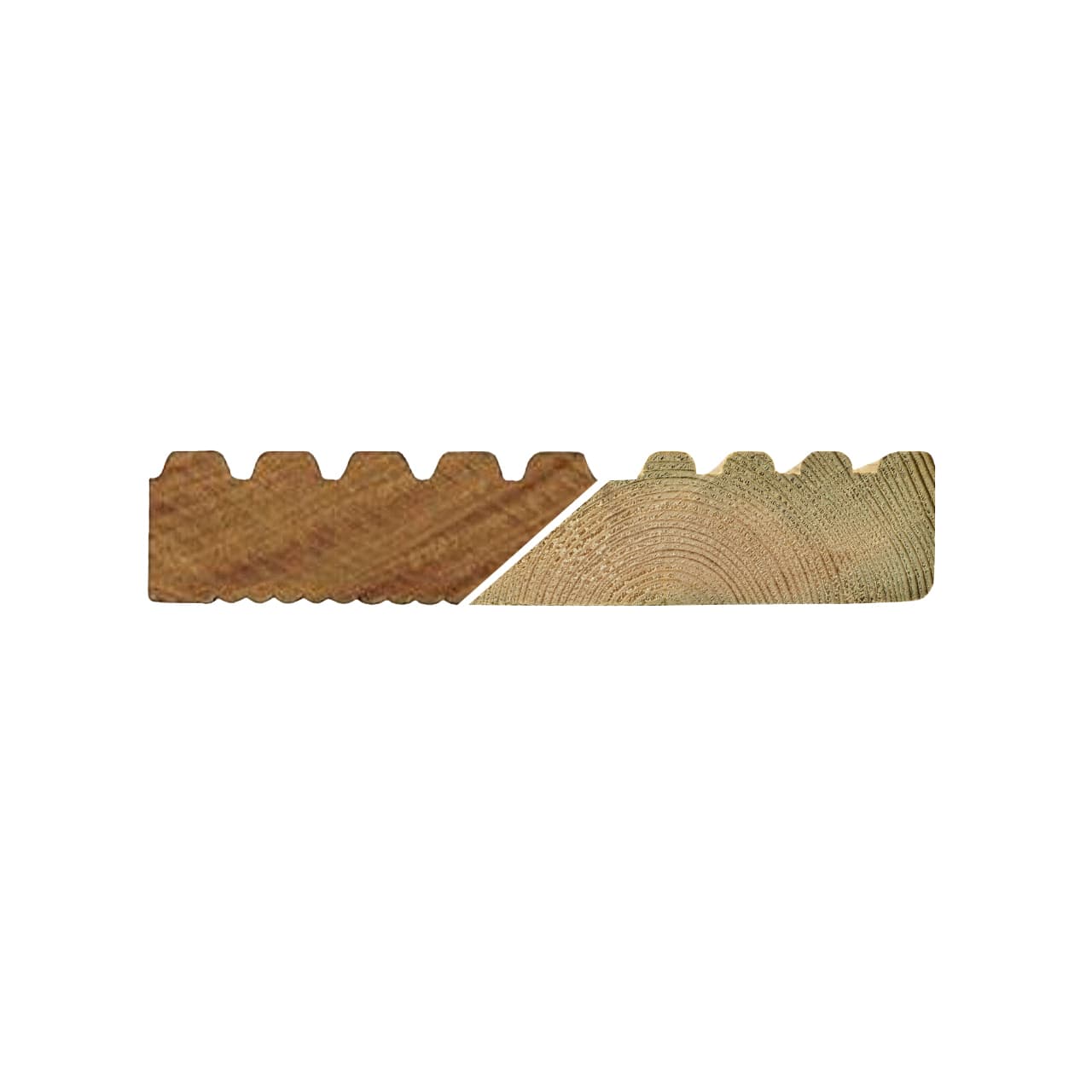Timber Decking Boards
(16 Products)Timber decking offers a warm, natural alternative to traditional hard landscaping materials, such as paving slabs or concrete. Our timber decking boards are reversible, offering two distinct surface profiles on a single board. This provides flexibility in design and application, allowing you to choose the look and feel that best suits your project.
What are Softwood Timber Decking Boards?
Softwood reversible decking boards are manufactured from fast-growing coniferous trees such as Scandinavian redwood pine or spruce.
Their naturally straight grain and light, honey-coloured tone lend an easy, “clean” aesthetic that can be left to weather to a silvery grey or stained any colour you like.
Because softwood species reach harvest size in just a few decades, the timber they yield is plentiful. This combination of fast growth and ready supply means softwood boards cost less per square metre than hardwood equivalents. This makes them an economical choice for large domestic decks or property upgrades.
Each reversible board we offer carries two contrasting surface profiles, meaning each plank can be flipped to achieve a different aesthetic. If one side becomes worn or marked, you can simply flip it over without replacing.
Why Choose Softwood For Your Deck?
Real wood brings a warmth you can’t fake. The knots, ripples of grain, and gentle shifts in colour give each board its own character, something plastic alternatives don't always capture.
Softwood is equally capable of creating a simple, ground-level platform as it is a split-level terrace with wrap-around benches, planters, and a few staggered steps. The boards saw, shape, and finish without protest, so your design ideas don’t have to stay on paper.
Set timber beside shrubs, lawn, or a mature tree and it just feels right. The material shares a palette with the garden, letting the whole space knit together instead of looking bolted on.
There’s also a financial upside. Estate agents often point to a well-kept deck as a selling feature, and buyers like spaces they can use the minute they get the keys, raising curb appeal and, more often than not, the asking price.
Softwood decking also brings a sense of comfort into an outdoor space. On a chilly spring morning timber holds a little warmth, so you can pad out barefoot without that sharp gasp you get from stone or concrete. Once you’ve felt the difference, it’s hard to go back.
Applications
- At Home: Garden decks, raised patios, and quiet corner terraces.
- Commercial Spaces: Outdoor dining areas in cafes, pubs, and restaurants.
- Public Projects: Footpaths, platforms, and seating areas in parks, community gardens, and shared outdoor spaces.
- In Landscaping: Edging paths, building steps, or blending into larger garden layouts as part of the design.
Benefits
- Built to Last: Pressure treatment helps protect the timber from moisture, rot, insects, and general wear, extending its usable life outdoors.
- Design-Friendly: The boards have two different surface finishes, giving you flexibility to switch up the look without changing materials.
- More for Your Money: Softwood is a lower-cost alternative to hardwood but still performs well with the right care, making it a popular pick for larger projects.
- Easy to Work With: Standard board sizes fit common subframe layouts, so the build process is usually quicker and smoother, even for DIYers.
Maintaining Your Timber Deck
Regular Cleaning
Sweep away leaves, soil, and debris. Reduce fungal growth and surface slipperiness by clearing the gaps between boards so rainwater drains freely.
Annual Deep Clean
Scrub along the grain with warm water and a stiff deck brush. Alternatively, use a purpose-made cleaning solution that targets algae and moss.
A pressure washer is acceptable on its lowest fan setting, provided the nozzle remains in motion and at least 300mm from the surface.
Re-Oiling, Staining, or Sealing
Apply a premium exterior oil, stain, or clear sealer formulated for decking.
Work only on a clean, completely dry surface and follow the manufacturer’s coverage rates. Finish each stroke in the direction of the grain.
Inspections
Check for loose fixings, raised fasteners, splintered edges, or early signs of decay. Tighten screws, sand minor splinters, and treat any soft patches with an appropriate preservative straight away.
Frequently Asked Timber Decking Questions
Can Softwood Decking Be Installed Directly On Soil Or Grass?
No, softwood decking should never be installed directly on soil or grass. Direct contact with the ground will lead to rapid rot and decay, even for pressure-treated timber, as it traps moisture and encourages fungal growth.
Decking must always be installed on a well constructed sub-frame (joists and bearers) that is elevated above the ground. This ensures adequate ventilation and drainage underneath the deck, which is crucial for the longevity of the timber boards and the structural integrity of the entire deck.
Can I Paint Over Softwood Decking Boards Straight Away?
Unless timber is specifically labelled as "Kiln Dried After Treatment" (KDAT), freshly pressure-treated wood contains a significant amount of moisture from the treatment process. Painting too soon will lead to poor adhesion, bubbling, peeling, and premature failure of the paint or stain.
The most reliable method to test if it's ready for painting is the water droplet test: sprinkle a few drops of water on the timber surface. If the water beads up, the wood is still too wet. If it soaks in, it's generally ready for coating. Professionals may use a moisture meter (aiming for 19% moisture content or less).
What Maintenance Do Softwood Decking Boards Require?
To maintain their appearance and longevity, it's recommended to clean the decking boards regularly and apply a water-repellent treatment every two to three years.
What Type Of Finish Is Best For Protecting Softwood Decking?
Using a high-quality, UV-resistant sealant will help protect the wood from sun damage and moisture, thereby preserving its colour and reducing the risk of warping or splitting.






